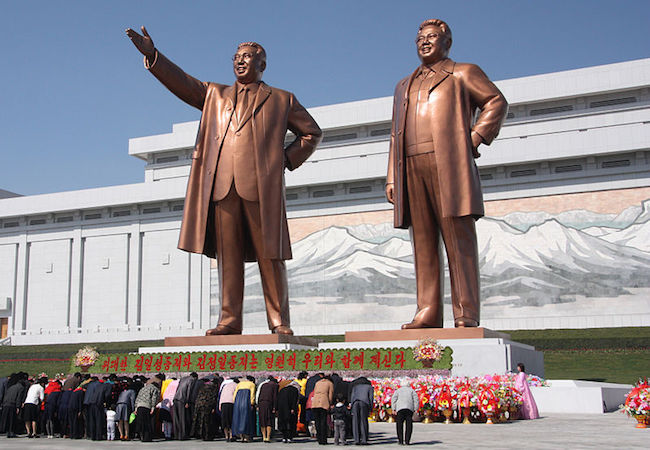Changing the approach toward North Korea’s denuclearization

By Hideyuki Yamamoto
U.S. negotiations with North Korea have failed to stop North Korea from developing nuclear weapons. Now that North Korea possesses nuclear weapons, the U.S. should change its approach toward “denuclearization.” The U.S. should first pursue an arms control agreement as an urgent issue and regard full denuclearization as an issue that should be solved in the mid-long term future. The U.S. should offer partial relief from economic sanctions in exchange for the arms control agreement, monitored by International Atomic Energy Agency (IAEA) inspections.
Currently, North Korea possesses an inter-continental ballistic missile that can reach Washington D.C. in about 40 minutes. Also, North Korea is further enhancing military capabilities, making U.S. efforts to stop its missile from hitting U.S. mainland after launch more difficult. As time goes by, North Korea will continue to miniaturize nuclear warheads and increase the number of its nuclear weapons, making U.S. efforts to defend against North Korea more difficult. Meanwhile, North Korea will be able to benefit more from negotiations, which is called the “time-technology dilemma.”
On June 12, 2018, North Korea leader Kim Jong-un and President Trump met in Singapore and signed a joint statement pledging to pursue lasting peace and complete denuclearization of the Korean Peninsula. However, negotiations have not proceeded ever since.
Earlier efforts at denuclearization failed as well. A 1994 “Agreed Framework” promised that the U.S., South Korea, and Japan would provide North Korea with 2 light-water reactors and additional energy supply in return for North Korea freezing its nuclear facilities at Nyongbyon and allowing IAEA inspectors. However, this framework did not work out. Allegedly, North Korea did not abide by the agreement, and as a result, the U.S. did not implement it.
Reflecting on past failures, the U.S.-North Korea arms control agreement should aim at decreasing North Korea’s nuclear capabilities to a level where it does not pose a threat to the U.S. mainland. Based on this agreement, the U.S. would partially relieve sanctions and North Korea would freeze developing its nuclear attack capability along with the IAEA inspection.
Since North Korea demanded sanctions relief before denuclearization in the past negotiations, the U.S. would provide partial relief first, such as removing sanctions on the import of seafood which will not benefit the military. After this, North Korea would freeze the development of its nuclear attack capability. The implementation of this agreement will be monitored by IAEA inspections.
This policy has three main benefits. First, it will break the current stalemate and lead to the resumption of negotiations. North Korea is possessing nuclear weapons in order to secure its county from attacks. By permitting the possession of limited nuclear attack capability, North Korea will feel secured. Second, it will improve the lives of the North Korean people, nearly half of whom are undernourished. By lifting the sanctions, it will benefit the citizens in North Korea. Third, by freezing the development of further nuclear attack capability that can pose a threat to the U.S., the U.S. can make itself more secure, and thus reduce the effect of “time-technology dilemma.” This is especially important in the era of great power competition when the U.S. needs to focus its limited resource on dealing with countries such as China and Russia. The U.S. forces would be able to focus more on the operations dealing with China and Russia instead of North Korea. Additionally, by halting the process of the “time-technology dilemma,” the U.S. will be able to prevent North Korea from gaining an edge over the U.S. in future denuclearization negotiation.
Critics will say that this policy acknowledges and accepts North Korea’s possession of nuclear weapons. The past approach, to prevent North Korea from developing nuclear weapons, failed. This policy, first pursuing an arms control agreement, which will permit North Korea to possess limited nuclear attack capability, with IAEA inspections, would make the U.S. able to control North Korea’s nuclear power and lead to a future full denuclearization agreement.
Also, some might argue that acknowledging North Korea’s possession of nuclear capability will enhance fear of Japan and South Korea. This might hold true since these countries depend greatly on the U.S. for their deterrence. However, the fear can be mitigated by the U.S. expressing stronger commitment to these countries. In a tangible way, it can deploy additional forces in or near these countries. In an intangible way, it can announce publicly that the U.S. will commit more and also stipulate stronger commitment in a law, such as National Defense Authorization Act (NDAA).
Currently, North Korea is estimated to have 30 to 60 nuclear weapons. Also, it is developing the delivery capability. The current situation of not doing anything towards denuclearization is the beginning of the worst-case scenario. By changing the approach toward North Korea, the U.S. would be able to secure its country more and make progress in future negotiations to denuclearization.
Hideyuki Yamamoto is a first year student at M.A. Security Policy Studies, Elliott School of International Affairs, George Washington University. His speciality is in Security Policy of East Asia.




